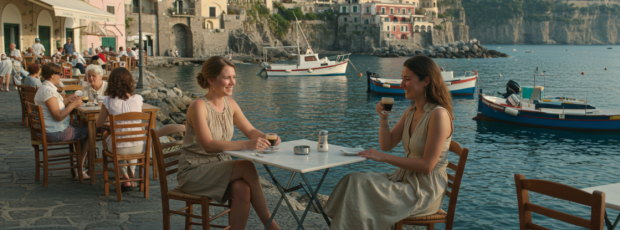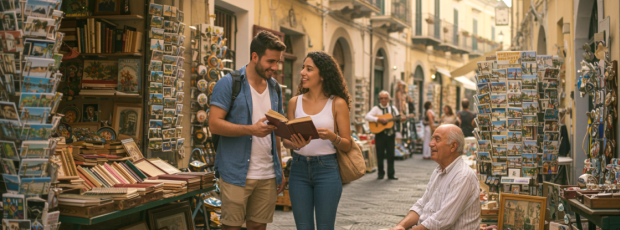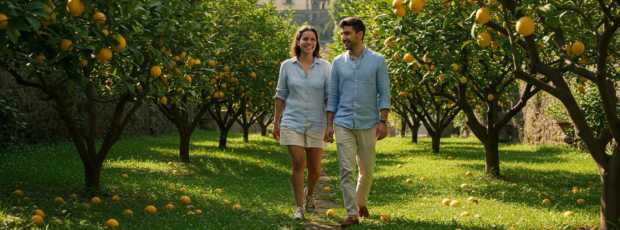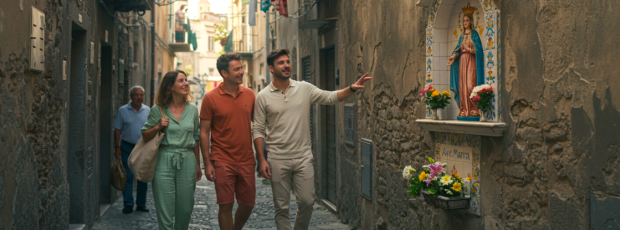Table Of Contents
- Early Morning in Sorrento at Marina Grande
- Sorrento Italy: Historic Center Awakens
- Villa Comunale Park: Sorrento's Breathtaking Views
- Piazza Tasso: Sorrento's Main Square
- San Francesco and Chiostro di San Francesco
- Exploring Sorrento's Vallone dei Mulini: Ancient Ruins
- Corso Italia: Heart of Sorrento Shopping
- Via San Cesareo and Historic Streets
- Lunch: Fresh Fish and Traditional Dishes
- The City Center Afternoon
- Basilica di Sant'Antonino: City's Patron Saint
- Museo della Tarsia Lignea
- Piazza della Vittoria Views
- Lemon Groves: Heart of Sorrento's Identity
- Marina Piccola: Beach Clubs and Boat Tours
- Evening Light in Sorrento's Streets
- Bagni della Regina Giovanna
- Traditional Cuisine for Dinner
- Italian Food and Fresh Fish
- Cultural Events and Evening Activities
- Day Trip Base: Explore Naples
- Souvenir Shops and Final Walks
- Getting Around Town
- What Makes Sorrento Special
- All the Things in One Day
- Planning Your Sorrento Day Trip
- Beyond the Tourist Trail in Sorrento
- Final Thoughts on Sorrento
After thirty-seven years in this town, I still wake before my alarm. The golden light filtering through my shutters carries that particular quality of an Italian summer morning. If you're planning your one day in Sorrento, let me share how I'd spend it. Not rushing through a checklist, but letting the town's natural rhythm guide you through everything Sorrento has to offer.
Early Morning in Sorrento at Marina Grande
The beauty of Sorrento at dawn belongs entirely to locals. I slip from my apartment near the train station toward Marina Grande, where fishing boats head out for their morning catch. The narrow streets are cool, filled only with my footsteps on ancient stone and distant seagull calls that echo through Sorrento's quiet morning.
Marina Grande isn't just a ferry port. It's where Sorrento's soul lives. The colorful houses glow in morning light, and old men at cafés nod as I pass. You feel the authenticity immediately. It's not performed for tourists, just Tuesday morning in a fishing village that captures the best of Sorrento, Italy, and the authentic charm of the Amalfi Coast.
Sorrento Italy: Historic Center Awakens
Walking through the old town in early morning reveals Sorrento, Italy, at its most genuine. The historic streets wind between buildings that have stood for centuries, each telling stories of how Sorrento evolved from a fishing village to a beloved stop on the Amalfi Coast. Every corner of Sorrento holds these stories.
The old town comes alive gradually. Shopkeepers roll up shutters along historic streets, café owners set up tables in small squares, and the scent of fresh espresso mingles with sea air. This is when you truly understand why spending one day in Sorrento feels like capturing an entire Italian summer, experiencing the essence of Sorrento, Italy, and understanding what makes Sorrento so special.
Looking for a private city experience in Sorrento?
Explore the city with a local who plans a private day just for you; no groups, no scripts.
Villa Comunale Park: Sorrento's Breathtaking Views
By 8 AM, I'm climbing toward Villa Comunale. The short walk from Marina Grande gives your first taste of how Sorrento cascades down cliffs. Villa Comunale Park sits at the cliff's edge, offering that breathtaking view everyone talks about. Mount Vesuvius rises across the bay, and Capri floats in the distance.
Villa Comunale Park draws me up the hill with good reason. Local families bring children before school, elderly couples take morning walks, and visitors get their first sense of scale. It's the town's natural meeting place, perched above the sea with views that take your breath away.
Piazza Tasso: Sorrento's Main Square
From Villa Comunale, you can't miss Piazza Tasso, the main square serving as Sorrento's beating heart. Named after Sorrento's most famous poet, this square is where everything converges. The train station sits just above it, Corso Italia runs right through it, and every important street radiates from here.
Once you grasp Piazza Tasso, you grasp the town. It's not just a square. It's where the entire community performs its daily life. Café owners set up tables. Shop owners roll up shutters. Locals head to work, all moving in choreography perfected over generations.
San Francesco and Chiostro di San Francesco
Just minutes from the square's activity, the historic church offers something different. The Chiostro di San Francesco, with ancient arches and peaceful gardens, feels like stepping into another century. The bell tower, visible from most areas of town, serves as your compass when exploring.
The Chiostro di San Francesco is one of the town's most serene spaces. This medieval cloister, with its perfectly preserved arches and tranquil garden, shows how the community has always balanced the sacred and secular.
What if your day in Sorrento was planned by someone who knows it — and you?
City Unscripted matches you with a local host who creates a private experience based on your interests, not a set route.
Exploring Sorrento's Vallone dei Mulini: Ancient Ruins
One of my favorite spots is Vallone dei Mulini, the ancient valley cutting through the town's heart. These ruins tell stories going back centuries. They were once mills that powered the local economy, now quietly overtaken by vegetation. The crumbling structures sit in the modern center, a perfect metaphor for adaptation.
Corso Italia: Heart of Sorrento Shopping
By mid-morning, I'm walking down Corso Italia, the main street running through the town's entire length. It's more than shopping. This is where you see how the community functions as a living place. Corso Italia reveals layers of the local economy. Tourism, yes, but also the daily life of residents who’ve lived here for generations.
Via San Cesareo and Historic Streets
Halfway down Corso Italia, you'll find Via San Cesareo, one of the historic streets leading seaward. This is where real exploring begins. Narrow streets and hidden courtyards make the town feel like a small village rather than a major Amalfi Coast stop.
Tip
We match you with the right host, not just any guide.Want to experience the real Sorrento with someone who lives there?
A fully private experience, planned and led by a local host who tailors the day to you
Lunch: Fresh Fish and Traditional Dishes
For lunch, I recommend returning to Marina Grande. The fresh fish comes directly from boats you watched heading out this morning. The food here isn’t complicated. Just fresh ingredients, simple preparations, and local recipes perfected over generations.
Restaurants along Marina Grande specialize in fish dishes that highlight the best of Italian food. These traditional meals embody generations of culinary wisdom, perfectly capturing the flavors of Sorrento, Italy.
The City Center Afternoon
After lunch, I walk back toward the city center, taking side streets most visitors miss. These narrow streets, barely wide enough for two people, hold the old town's real character and give you a glimpse of authentic local life. They're part of what makes exploring Sorrento so rewarding.
Basilica di Sant'Antonino: City's Patron Saint
The Basilica di Sant'Antonino, dedicated to the city's patron saint, sits at the heart of these historic streets. Saints Philip and James are honored here too, and the church reminds you that Sorrento has always been where faith and daily life intersect.
Ready to plan your perfect day in Sorrento?
Start your experienceMuseo della Tarsia Lignea
A day in Sorrento should include the Museo della Tarsia Lignea, the wood inlay museum. The town has been famous for woodwork for centuries, and this museum shows how local artisans keep traditions alive. You'll understand why these artisan shops matter to the local identity.
Piazza della Vittoria Views
From the museum, walk toward Piazza della Vittoria, another important square. Less crowded than Piazza Tasso, it offers a different view of how the town is laid out. The view from Piazza della Vittoria takes in another stretch of the coastline, showing how the community extends along the cliffs.
Lemon Groves: Heart of Sorrento's Identity
As afternoon progresses, the light begins to change. I love spending time in lemon groves on the outskirts of town and in the surrounding hills. These are working farms that have been here for generations. The lemon trees aren't just beautiful. They're central to local identity, perfect for the limoncello every family makes. These groves are quintessentially Sorrento.
Families have tended these lemon groves for centuries. They're not just decorative gardens, but working agricultural spaces that have supported local life for a long time. The lemon trees here produce those famous local lemons, prized throughout Italy and symbolic of Sorrento's agricultural heritage.
Marina Piccola: Beach Clubs and Boat Tours
Marina Piccola, the smaller port area, is less crowded than Marina Grande but equally beautiful. You'll find boat tour operators and exclusive waterfront establishments here, but it’s still a great spot to watch the day end, even without the extra cost.
The establishments at Marina Piccola offer a different experience from the more casual atmosphere of Marina Grande. If you're considering a tour along the Amalfi Coast, many boats depart from here. The crews know these waters well and can show you perspectives from the sea that reveal the coastline's full beauty.
Even if you don't join a boat tour or pay for waterfront access, Marina Piccola provides stunning views and a peaceful place to reflect on your day in Sorrento.
Evening Light in Sorrento's Streets
By evening, I'm back in the main area, but everything looks different. The setting sun turns stone buildings golden, and shadows create intimate spaces. This is when the town naturally shows its most romantic side.
Bagni della Regina Giovanna
If you have a few extra hours, the ruins at Bagni della Regina Giovanna are worth the walk. These ancient Roman ruins, where Queen Giovanna supposedly bathed, sit at the water's edge. The walk takes you through some of the area’s most beautiful coastline.
Traditional Cuisine for Dinner
For dinner, return to the old town. After a full day exploring, you've earned a proper meal. Restaurants near Piazza Tasso and Via San Cesareo offer traditional cuisine and modern takes on regional dishes, made with ingredients from the surrounding area.
Italian Food and Fresh Fish
The evening meal brings together all the day's flavors. You'll taste fresh fish from Marina Grande, lemons from local groves, and herbs from the surrounding hillsides. Italian food here isn't just about individual ingredients. It's how they come together to create something greater, perfectly representing the essence of this place.
Cultural Events and Evening Activities
As evening settles, you have a few options. Take a guided tour of the illuminated streets, join local festivities if available, or simply walk and absorb the atmosphere. In my previous post about local evenings, I mentioned how the town transforms after dark.
Exploring the streets at night reveals different sides of the town’s character. Local events might include festivals, concerts, or seasonal celebrations that offer a glimpse into how Sorrentines celebrate their heritage.
Day Trip Base: Explore Naples
The town's perfect location on the Amalfi Coast means you could spend your entire trip here, using it as a base to explore Naples or visit nearby coastal towns. The train station provides easy access to Naples, while ferries connect to islands and other seaside destinations. This flexibility is one of Sorrento's greatest advantages for exploring the entire Amalfi Coast region.
Many visitors choose Sorrento as their base for discovering southern Italy. You can easily take a day trip to Naples, visiting its old town, museums, and famous pizza spots. The train connection makes it simple to enjoy both coastal beauty and urban culture during your stay. That’s part of what makes Sorrento such an ideal hub for travel.
Souvenir Shops and Final Walks
Before leaving, browse the souvenir shops along Corso Italia, and take time to duck into the many churches that dot the town. Each tells part of the local story, from defensive walls built centuries ago to modern additions that show how the community continues to evolve. History lives in layers here, helping define what makes Sorrento special.
Getting Around Town
The town is perfectly walkable. Every major sight is within a short walk of the others. Steep, winding streets connect the different levels of the town, and the layout becomes intuitive once you understand the basic geography.
What Makes Sorrento Special
I love showing people this town because it isn't just a place you visit. It visits you back. The flavors stay. The views replay in your memory, and the town's rhythm becomes part of your internal soundtrack.
All the Things in One Day
A day in Sorrento teaches something important about travel and life. You don't need to see everything to understand everything. You don't need to rush through a list to feel you've really been somewhere.
Planning Your Sorrento Day Trip
Whether you're planning local festivities, looking for Sorrento experiences, or wondering what to do in Sorrento for a day, remember that the best experiences aren't always planned.
Beyond the Tourist Trail in Sorrento
Consider taking a cooking class with locals, visiting Café Latino for aperitifs, or finding a quiet spot at Villa Comunale for stunning views. These experiences, along with visits to lesser-known spots blessed by Padre Reginaldo Giuliani, show the town's deeper character.
A cooking class is one of the best ways to understand local cuisine beyond just eating in restaurants. Café Latino, located near Piazza Tasso, represents the kind of authentic local experience that makes a day in Sorrento special. The terraces at Villa Comunale offer some of the most stunning views in town, while the area around Piazza Tasso provides endless opportunities for discovery.
Final Thoughts on Sorrento
That's the real magic of Sorrento. Not just its beauty, but how it reminds you to pay attention. How to let a place like this teach you its secrets. How to carry a single perfect day in Sorrento with you forever, whether it's part of a larger Italy adventure or a focused visit to this remarkable corner of Sorrento, Italy.
What if your day in Sorrento was planned by someone who knows it — and you?
City Unscripted matches you with a local host who creates a private experience based on your interests, not a set route.
Want to experience the real Sorrento with someone who lives there?
A fully private experience, planned and led by a local host who tailors the day to you











